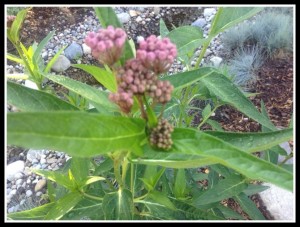As summer fades into fall, Monarch butterflies in North America are making their way from their summer homes to their overwintering locations in Mexico and California. Get the latest information on weekly migration updates for the Monarchs.
This post will cover three important ways you can help the Monarch butterflies, whose numbers have declined significantly in recent years.
Plant Milkweed
If, like the crew of Serendipity Gardens, you are concerned about the Monarchs, you may have planted milkweed in your garden this year. If you did not plant milkweed this year, you can plan to do so next year.
According to National Geographic’s website, “Milkweed is the only plant on which Monarch butterflies will lay their eggs, and it is the primary food source for Monarch caterpillars.” In spite of this fact, the plant decreased 21 percent in the United States between 1995 and 2013. Scientists, conservationists, and butterfly enthusiasts are suggesting that people like you and the crew at Serendipity Gardens can plant milkweed in their own yards and gardens to help offset this loss.
Milkweed seeds are not that easy to find.
To address this seed shortage, the Xerces Society launched Project Milkweed. Xerces is producing new sources of milkweed seed in areas of the Monarch’s breeding range where seed has not been reliably available: California, the Great Basin, Arizona, New Mexico, Texas, and Florida. The non-profit organization also provides a milkweed finder, which you can use to find what milkweed seeds are available in your state and how to get them.
Donate
Many of the organizations working to preserve the Monarch butterfly and in particular, their annual migration, are non-profit organizations. Here is a short list of places you can donate. You can locate others via the Internet.
Volunteer as a Citizen Scientist
You can also help the Monarchs by participating in a butterfly project as a Citizen Scientist. Several butterfly-related monitoring projects are listed on the Monarch Joint Venture website. Here are just three of the ones that focus on Monarch butterflies specifically. These organizations would welcome your input.
Journey North has this to say: “Citizen scientists track the Monarch butterfly migration each fall and spring as the Monarchs travel to and from Mexico.” Here are some things you can do:
- Report your own observations of migrating butterflies to real-time migration maps.
- Share data to help scientists understand how Monarchs respond to climate and changing seasons.
- Explore Monarch butterfly life cycle, ecology, habitat and conservation needs.
The site provides an app that makes it easy for you to participate. You can download the iPhone app from the iTunes App Store, and get the Android App on Google Play.
The Southwest Monarch Study studies the migration patterns of Monarch butterflies in Arizona. This study conducts several activities that can use the help of citizen scientists:
- Tagging Monarch butterflies during their Fall migration from August through November.
- Monitoring milkweed populations throughout the West.
- Searching for habitats that attract Monarch butterflies
People of all ages are welcome to participate. Southwest Monarch Study also provides educational programs to raise Monarch awareness.
The Monarch Larva Monitoring Project
The primary goal of the Monarch Larva Monitoring Project (MLMP) is to increase understanding of how and why Monarch populations vary in time and space, with an emphasis on Monarch distribution and abundance during the breeding season in North America. The project relies on citizen science and seeks to engage volunteers from across North America. Researchers at the University of Minnesota developed the project to collect long-term data on larval Monarch populations and milkweed habitat.
As an MLMP volunteer, you are helping to preserve Monarchs and their threatened migratory phenomenon. You are also advancing our understanding of butterfly ecology in general.
Four Surprising Facts about the Monarch Migration
- Each year, about five generations will be born to continue migrating north. It is only the last generation, born in late summer that will live eight months and migrate back to Mexico to start the cycle over again.
- The Monarchs’ life span is so short that those making the next migration to Mexico or California will be the great-grandchildren of the previous migrators.
- Individual Monarch butterflies can fly thousands of miles while migrating.
- The Monarch is not considered an endangered species. It is the insect’s unique migration that is in jeopardy.
Like this post? Sign up to receive an email each time a new post is available. We will never loan, sell or rent your email address — that’s a promise! Please use the buttons below to share with others.
